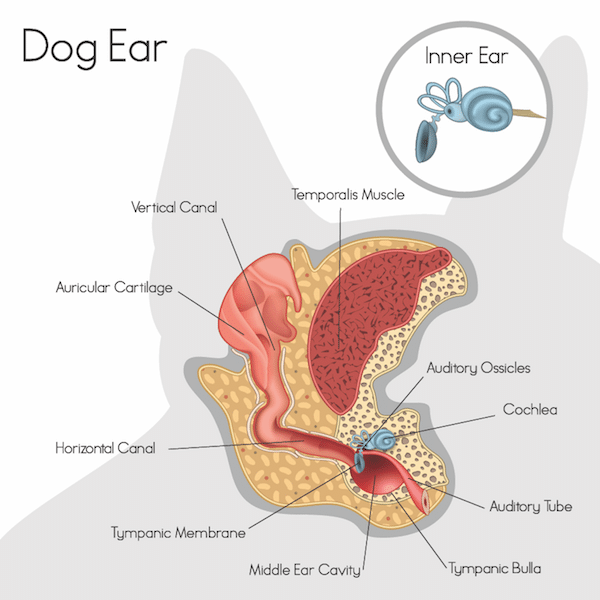Editor’s note: Have you seen the Dogster print magazine in stores? Or in the waiting room of your vet’s office? This article appeared in our February-March issue. Subscribe to Dogster and get the bimonthly magazine delivered to your home.
You betcha! According to current statistics from major pet insurance companies, ear infections rank from the No. 1 to the No. 2 reasons for claims in dogs. Ranking with top claims are also skin allergies, which typically go hand in hand with most ear infections.
Allergies are not the only cause of ear infections in dogs. Sometimes the breed or shape of the dog’s ear canal can predispose him to ear infections. Conditions like ear foreign bodies, ear mites, gland tumors and polyps, and even endocrine disorders can be at the root of an ear infection. Ear irritation and infection (bacterial and/or yeast overgrowth) can also range from only mildly annoying to significantly life-altering depending on the severity and location of infection within the ear.
Disease conditions affecting the middle and inner ear are otitis media and otitis interna, respectively and can spell big trouble if nerves are affected.

Dog ear anatomy by Shutterstock.
“What’s that smell?”
The most common ear infections come as a consequence of seasonal allergies. Allergy associated inflammation affecting the skin can extend into the ear canals where naturally occurring yeast and bacteria can start to overgrow. Owners may notice their dog shaking his head and even pick up an offensive smell. Dark brown or even yellow, waxy goop may accompany the odor. Ear tissues can become red, inflamed, and painful.
Another condition that can predispose a dog to ear infections is the shape of the breed’s ear canal. For example, Pugs and Chinese Shar-Pei dogs can have a significantly collapsed or narrowed ear canal (stenosis). This can allow waxy debris to accumulate and provide ideal growth media for bacteria and yeast.
Some breeds may have a normal canal shape but lots of hair growing in the canal. Under normal conditions this may not cause a problem. However, in an animal with allergies, the hair can additionally contribute to waxy debris and microbe accumulation. Breeds with natural canal hair and no history of ear problems should not be plucked as it could cause irritation and bacterial and yeast bloom.
Carefully consider using any ear cleaning products in dogs that do not have a history of ear issues. “If it ain’t broke, don’t fix it” is a good rule of thumb here.
What is that?
Other sources of sore ears are foreign material, such as grass awns, aka foxtails. Lodged deep within any part of the ear, they can cause a heap of trouble and may be undetectable without a veterinarian visit.
Ear mites can barely be seen with the naked eye but in large numbers cause itching, irritation, and a lot of dry, black debris. Even after the mite infection has been cleared with a miticide, secondary bacteria and yeast overgrowths may cause trouble.
Occasionally, benign tumors and polyps arising from the glands lining the ear canals can cause discomfort and even canal obstruction. Believe it or not, endocrine diseases like low thyroid function (hypothyroidism) can manifest with chronic skin and ear issues.

Dog ears by Shutterstock.
The consequences
Depending on the region of the ear affected by infection, consequences can be painful and unpleasant. In otitis externa, pain and inflammation can lead to repeated head shaking that can traumatize the pinna and cause bleeding underneath the skin of the ear (aural hematoma). The affected pinna can puff up like a marshmallow and be uncomfortable as well as a nightmare to treat.
Chronic infections of the external ear tissues can lead to thickening and stenosis of the canals and even lead to ruptured eardrums and temporary deafness. Deeper infection causing otitis media and otitis interna can lead to irritation of the vestibular and facial nerves. If this occurs, a dog can develop head tilt, dizziness, uncontrolled rolling, or other vertigo-like signs.
Now what?
Since shaking heads and itchy ears usually indicate ear irritation, visit your veterinarian to get it checked. Visual inspection using an instrument called an otoscope will help your vet look deep into canals to identify the problem.
In most cases, prescribed topical medications containing anti-inflammatory and antimicrobial agents can resolve common ear infections. Diseases affecting the deeper bony chambers of the ear may require more advanced diagnostic imaging like MRI or CT scans to identify the problem.
Dogs with chronic uncontrolled allergies are at higher risk for ear infection recurrence. Once identified, managing chronic health conditions that affect your dog’s ears can help to reduce the frequency and intensity of his ear infections.
Can you hear me?
The construction of the canine ear includes a few more twists and turns compared to the human ear. The outer part of a dog’s ear that we can easily see is called the pinna. The characteristic pinna gives the different breeds some of their unique charm, but further down are the vertical and horizontal canals shared by all canine citizens. These ear canals are lined with delicate tissue consisting of cerumenous and sebaceous glands and keratocytes (cells similar to skin). Collectively, all these parts make up the external ear. Inflammation and infection of these areas is called otitis externa.
The vertical and horizontal canal leads to the eardrum (tympanic membrane). Various components critical in detecting sound and for maintaining a dog’s balance are located beyond the tympanic membrane. Two main chambers house these delicate components and are called the middle and the inner ear. The middle ear chamber includes a cavity called the tympanic bulla. This cavity contains the auditory ossicles, cochlea, and opening to the auditory tube, which connects to the nasopharynx and serves to equalize pressure on both sides of the tympanic membrane. Facial and sympathetic nerve fibers run through the canine bulla. Inflammation and infection involving the middle ear can cause malfunction of these nerves.
The inner ear chamber houses the delicate fluids and sensory hair cells that conduct impulses of balance through the vestibular nerve to brain, while sound impulses are transmitted via the cochlear nerve to the brain. Disease conditions affecting the middle and inner ear are otitis media and otitis interna, respectively and can spell big trouble if nerves are affected.
The post Can Dogs Get Ear Infections? appeared first on Dogster.
No comments:
Post a Comment